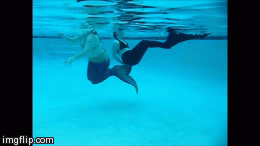So I've been looking a finswimming, a sport you don't see much here in the U.S. There are three types of finswimming: Apnea (breath holding finswimming), surface, and immersion finswimming.
Immersion finswimming, basically involves a SCUBA tank, but instead of it being strapped onto your back, you hold it while swimming. I'm wondering if this could be done using a tail, as it would allow freedom of movement, and the ability to stay down longer. Is this more of a pool thing, or could it actually be used in open water?
Here's a video of the SCUBA tank in use with finswimming, and the swimmers swim very fast with it. Does anyone know anything about this piece of equipment?
http://www.youtube.com/watch?v=O_j0Lxa8_qk









 Reply With Quote
Reply With Quote



















Bookmarks